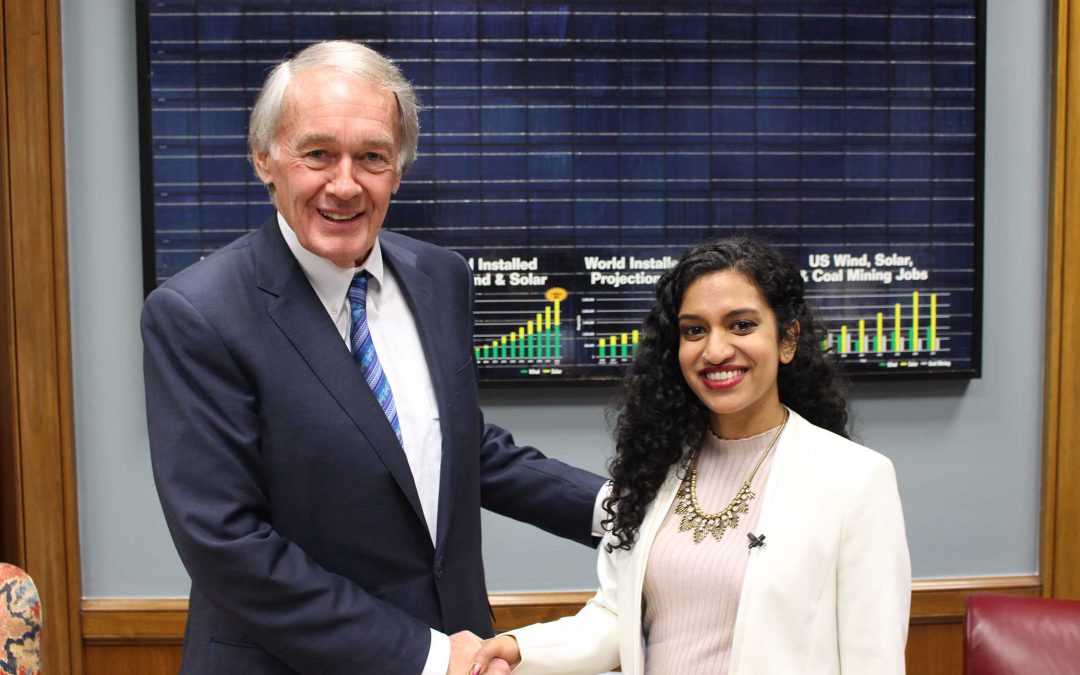WASHINGTON — In his second State of the Union address, President Donald Trump focused heavily on foreign policy, immigration and the need for a border wall while completely ignoring the environment and climate change, reflecting the issues important to his supporters.
The only time Trump mentioned natural resources was when he said, “The United States is now the number one producer of oil and natural gas in the world.”
Sen. Edward Markey, D-Mass. brought environmental activist Varshini Prakash to the State of the Union as his guest. Prakash is a co-founder of the movement Sunrise ,which gained national attention when hundreds of activists protested outside House Speaker Nancy Pelosi’s office after the midterm elections demanding that Congress support their Green New Deal. Incoming freshman Rep. Alexandria Ocasio-Cortez, D-N.Y., upped their visibility when she joined the protesters.
The three core principles of the Green New Deal are creating a carbon-free economy, investing in green jobs and promoting environmental justice, especially in poor communities. Markey and Ocasio-Cortez are expected to introduce Green New Deal legislation as early as this week.
“On the most important issue facing our country and its people – climate change – President Trump’s State of the Union was as empty as his schedules,” Markey wrote in a press release after the speech. “While temperatures rise and wages fall, President Trump continues his climate denial, letting Big Oil, King Coal and the Koch Brothers dictate an energy agenda that endangers public health, national security, and economic prosperity. Instead of Trump’s climate raw deal, America needs a green New Deal that transforms our economy, delivers justice, and unleashes the greatest blue-collar job creation program in a generation.
“So, when Donald Trump talks about compromise, what he really means is capitulation,” Markey wrote.
The Trump administration has pursued a policy of rolling back environmental regulations in order to spur economic growth. “My administration has cut more regulations in a short time than any other administration during its entire tenure,” Trump proudly told Congress Tuesday night.
National Geographic has tracked over 80 changes to science and environmental policy throughout the first two years of the Trump administration.
The Environmental Protection Agency has eased sulphur dioxide regulations on coal plant emissions. The Interior Department has eased restrictions on oil and gas drilling on protected habitat in western states. The Bureau of Ocean Energy Management issued the first permit to begin drilling in the Arctic’s Beaufort Sea. And a ban on the pesticide chlorpyrifos, which is in the same class of chemicals as sarin gas, was quashed by the scandal-plagued former head of the EPA, Scott Pruitt, in one of his first acts as director of the agency.
One day before the government shutdown in December, Trump issued an executive order to the Interior and Agriculture departments to ramp up logging on federal lands to 4 billion board feet, an increase of 31 percent. Trump has repeatedly stated on Twitter and in interviews that poor forest management is responsible for wildfires, though experts disagree.
Like Markey and Ocasio-Cortez, the military and intelligence communities have consistently been more concerned about climate change and the environment than the president.
Last week, Director of National Intelligence Dan Coats testified before the Senate Select Committee on Intelligence about the 2019 Worldwide Threat Assessment. Coats oversees the i Office of the Director of National Intelligence, which integrates the work of 17 organizations including the CIA and departments of State, Defense, Justice, Energy, Homeland Security, and Treasury as well as the Coast Guard and Drug Enforcement Agency.
For the third year in a row, the ODNI report highlighted global threats posed by climate change alongside threats posed by China, Russia, weapons of mass destruction and terrorism.
“Climate hazards such as extreme weather, higher temperatures, droughts, floods, wildfires, storms, sea level rise, soil degradation, and acidifying oceans are intensifying, threatening infrastructure, health, and water and food security,” the report stated.
The threat assessment also cited the dangers to military installations posed by rising sea levels.
“Damage to communication, energy, and transportation infrastructure could affect low-lying military bases, inflict economic costs, and cause human displacement and loss of life,” ODNI found.
This already happened when Hurricane Florence caused $3.6 billion damage to the Marine Corps’ Camp Lejeune in North Carolina in September 2018, followed one month later by $5 billion in damage to Tyndall Air Force base in Florida after Hurricane Michael, according to the Union of Concerned Scientists.
A January 2019 report on climate change risk by the Department of Defense reviewed 79 military installations and found 53 at risk of recurrent flooding, 43 vulnerable to droughts and 36 at risk of wildfires, with many installations threatened by more than one risk factor. Desertification and thawing permafrost were other risk factors.
“Congress needs to use the power of the purse to ensure that our federal spending prioritizes clean energy, climate change, and science, and restricts the ability of the Trump administration to take actions that would move us further away from our climate goals,” Markey wrote in a Dec. 7 op-ed in the Boston Globe. “In the 116th Congress, we will have that chance to make history. Now is the time for a green New Deal.”


